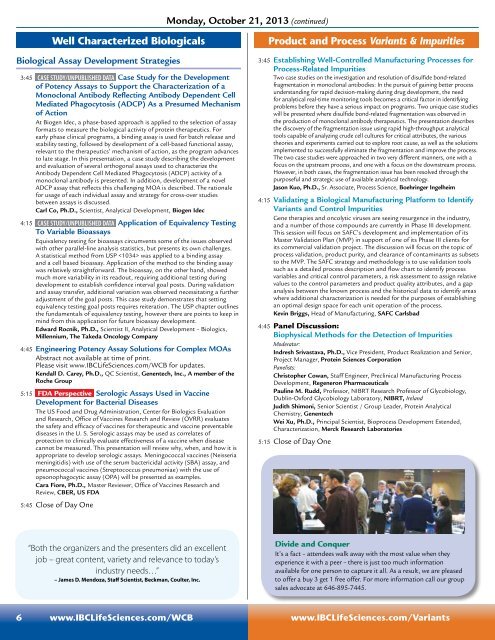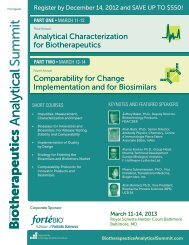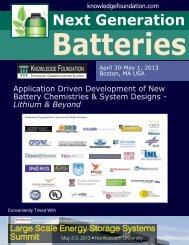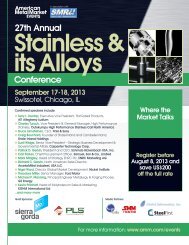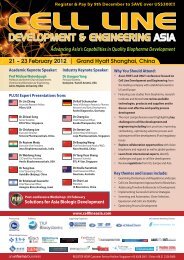Product and Process Variants & Impurities
Product and Process Variants & Impurities
Product and Process Variants & Impurities
- No tags were found...
You also want an ePaper? Increase the reach of your titles
YUMPU automatically turns print PDFs into web optimized ePapers that Google loves.
Monday, October 21, 2013 (continued)Well Characterized BiologicalsBiological Assay Development Strategies3:45 CASE STUDY/UNPUBLISHED DATA Case Study for the Developmentof Potency Assays to Support the Characterization of aMonoclonal Antibody Reflecting Antibody Dependent CellMediated Phagocytosis (ADCP) As a Presumed Mechanismof ActionAt Biogen Idec, a phase-based approach is applied to the selection of assayformats to measure the biological activity of protein therapeutics. Forearly phase clinical programs, a binding assay is used for batch release <strong>and</strong>stability testing, followed by development of a cell-based functional assay,relevant to the therapeutics’ mechanism of action, as the program advancesto late stage. In this presentation, a case study describing the development<strong>and</strong> evaluation of several orthogonal assays used to characterize theAntibody Dependent Cell Mediated Phagocytosis (ADCP) activity of amonoclonal antibody is presented. In addition, development of a novelADCP assay that reflects this challenging MOA is described. The rationalefor usage of each individual assay <strong>and</strong> strategy for cross-over studiesbetween assays is discussed.Carl Co, Ph.D., Scientist, Analytical Development, Biogen Idec4:15 CASE STUDY/UNPUBLISHED DATA Application of Equivalency TestingTo Variable BioassaysEquivalency testing for bioassays circumvents some of the issues observedwith other parallel-line analysis statistics, but presents its own challenges.A statistical method from USP was applied to a binding assay<strong>and</strong> a cell based bioassay. Application of the method to the binding assaywas relatively straightforward. The bioassay, on the other h<strong>and</strong>, showedmuch more variability in its readout, requiring additional testing duringdevelopment to establish confidence interval goal posts. During validation<strong>and</strong> assay transfer, additional variation was observed necessitating a furtheradjustment of the goal posts. This case study demonstrates that settingequivalency testing goal posts requires reiteration. The USP chapter outlinesthe fundamentals of equivalency testing, however there are points to keep inmind from this application for future bioassay development.Edward Rocnik, Ph.D., Scientist II, Analytical Development – Biologics,Millennium, The Takeda Oncology Company4:45 Engineering Potency Assay Solutions for Complex MOAsAbstract not available at time of print.Please visit www.IBCLifeSciences.com/WCB for updates.Kendall D. Carey, Ph.D., QC Scientist, Genentech, Inc., A member of theRoche Group5:15 FDA Perspective Serologic Assays Used in VaccineDevelopment for Bacterial DiseasesThe US Food <strong>and</strong> Drug Administration, Center for Biologics Evaluation<strong>and</strong> Research, Office of Vaccines Research <strong>and</strong> Review (OVRR) evaluatesthe safety <strong>and</strong> efficacy of vaccines for therapeutic <strong>and</strong> vaccine preventablediseases in the U. S. Serologic assays may be used as correlates ofprotection to clinically evaluate effectiveness of a vaccine when diseasecannot be measured. This presentation will review why, when, <strong>and</strong> how it isappropriate to develop serologic assays. Meningococcal vaccines (Neisseriameningitidis) with use of the serum bactericidal activity (SBA) assay, <strong>and</strong>pneumococcal vaccines (Streptococcus pneumoniae) with the use ofopsonophagocytic assay (OPA) will be presented as examples.Cara Fiore, Ph.D., Master Reviewer, Office of Vaccines Research <strong>and</strong>Review, CBER, US FDA5:45 Close of Day One<strong>Product</strong> <strong>and</strong> <strong>Process</strong> <strong>Variants</strong> & <strong>Impurities</strong>3:45 Establishing Well-Controlled Manufacturing <strong>Process</strong>es for<strong>Process</strong>-Related <strong>Impurities</strong>Two case studies on the investigation <strong>and</strong> resolution of disulfide bond-relatedfragmentation in monoclonal antibodies: In the pursuit of gaining better processunderst<strong>and</strong>ing for rapid decision-making during drug development, the needfor analytical real-time monitoring tools becomes a critical factor in identifyingproblems before they have a serious impact on programs. Two unique case studieswill be presented where disulfide bond-related fragmentation was observed inthe production of monoclonal antibody therapeutics. The presentation describesthe discovery of the fragmentation issue using rapid high-throughput analyticaltools capable of analyzing crude cell cultures for critical attributes, the varioustheories <strong>and</strong> experiments carried out to explore root cause, as well as the solutionsimplemented to successfully eliminate the fragmentation <strong>and</strong> improve the process.The two case studies were approached in two very different manners, one with afocus on the upstream process, <strong>and</strong> one with a focus on the downstream process.However, in both cases, the fragmentation issue has been resolved through thepurposeful <strong>and</strong> strategic use of available analytical technology.Jason Kuo, Ph.D., Sr. Associate, <strong>Process</strong> Science, Boehringer Ingelheim4:15 Validating a Biological Manufacturing Platform to Identify<strong>Variants</strong> <strong>and</strong> Control <strong>Impurities</strong>Gene therapies <strong>and</strong> oncolytic viruses are seeing resurgence in the industry,<strong>and</strong> a number of those compounds are currently in Phase III development.This session will focus on SAFC’s development <strong>and</strong> implementation of itsMaster Validation Plan (MVP) in support of one of its Phase III clients forits commercial validation project. The discussion will focus on the topic ofprocess validation, product purity, <strong>and</strong> clearance of contaminants as subsetsto the MVP. The SAFC strategy <strong>and</strong> methodology is to use validation toolssuch as a detailed process description <strong>and</strong> flow chart to identify processvariables <strong>and</strong> critical control parameters, a risk assessment to assign relativevalues to the control parameters <strong>and</strong> product quality attributes, <strong>and</strong> a gapanalysis between the known process <strong>and</strong> the historical data to identify areaswhere additional characterization is needed for the purposes of establishingan optimal design space for each unit operation of the process.Kevin Briggs, Head of Manufacturing, SAFC Carlsbad4:45 Panel Discussion:Biophysical Methods for the Detection of <strong>Impurities</strong>Moderator:Indresh Srivastava, Ph.D., Vice President, <strong>Product</strong> Realization <strong>and</strong> Senior,Project Manager, Protein Sciences CorporationPanelists:Christopher Cowan, Staff Engineer, Preclinical Manufacturing <strong>Process</strong>Development, Regeneron PharmaceuticalsPauline M. Rudd, Professor, NIBRT Research Professor of Glycobiology,Dublin-Oxford Glycobiology Laboratory, NIBRT, Irel<strong>and</strong>Judith Shimoni, Senior Scientist / Group Leader, Protein AnalyticalChemistry, GenentechWei Xu, Ph.D., Principal Scientist, Bioprocess Development Extended,Characterization, Merck Research Laboratories5:15 Close of Day One“Both the organizers <strong>and</strong> the presenters did an excellentjob – great content, variety <strong>and</strong> relevance to today’sindustry needs…”– James D. Mendoza, Staff Scientist, Beckman, Coulter, Inc.Divide <strong>and</strong> ConquerIt’s a fact – attendees walk away with the most value when theyexperience it with a peer – there is just too much informationavailable for one person to capture it all. As a result, we are pleasedto offer a buy 3 get 1 free offer. For more information call our groupsales advocate at 646-895-7445.6 www.IBCLifeSciences.com/WCB www.IBCLifeSciences.com/<strong>Variants</strong>


